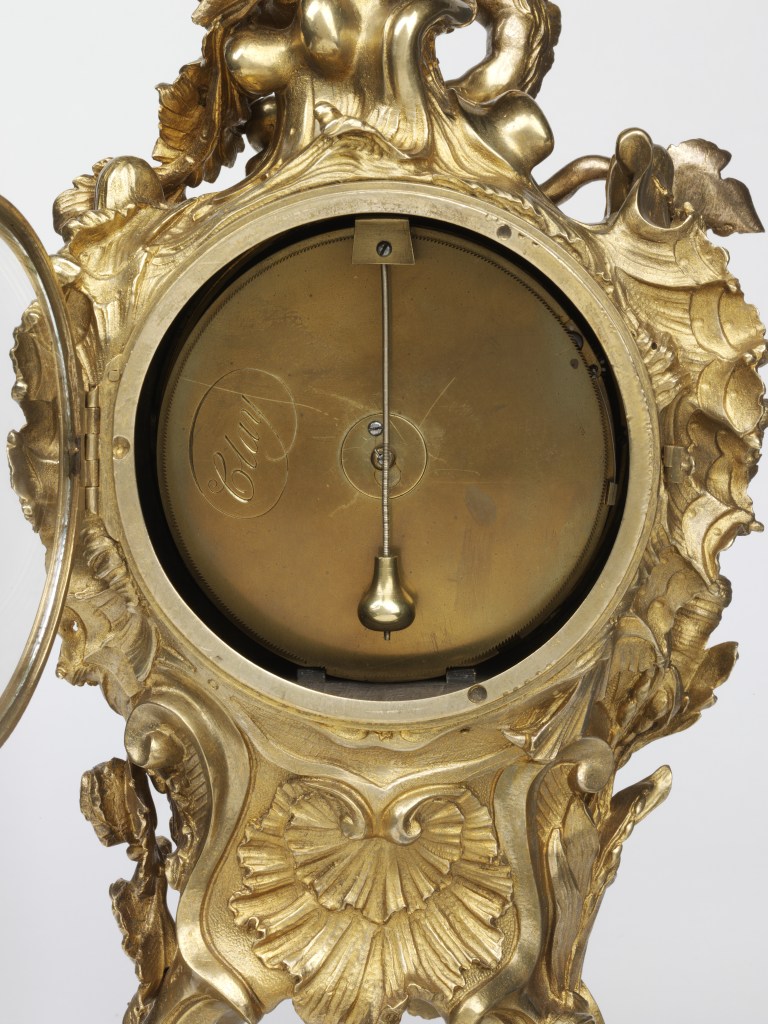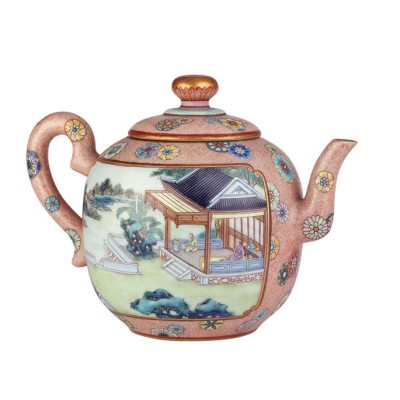On my first visit to Masterpiece 2015, I gathered that there was a clock by London-based maker Charles Clay (active 1720–40). The recent exhibition on Clay’s organ clocks that played tunes adapted by Handel at Handel House, London (Apollo, November 2013), had led me to expect a wooden-cased clock on pedestal like that in the Birmingham Museum and Art Gallery. I was rewarded on my second visit by finding a smaller clock in an ormolu case with Wiltshire furniture dealer Edward Hurst.
I immediately recognised the central gold plaque chased with the face of the sun on the dial as corresponding to the clock supplied by London Huguenot jeweller Peter Dutens to Frederick, Prince of Wales on 31 August 1736 at a total cost of £61 2s. I had transcribed the original bill in the Duchy of Cornwall archives in 1978 when researching Huguenot artists, designers, and craftsmen. The clock was no longer in the Royal Collection, so I assumed it did not survive. The vendor had traced it to the sale of the Duke of Sussex’s collection, Christie’s 22 June 1843 (lot 128) and suggested that it was likely commissioned by the Duke’s grandfather Prince Frederick. I sat down to conceal my excitement and gently asked Edward Hurst if he would consider a special museum price – his response drew from me the request to reserve the clock for the V&A.
Royal mantel clock made for Frederick Louis, Prince of Wales (1736). Victoria and Albert Museum, London

The bill records that Dutens charged 11 guineas for ‘a Clock Case bought at Paris’ and a further two guineas ‘coming over with Comission’. The four-inch ‘Dial Plate Enamel’d White & Blue with the Days & Months & Signs of the Zodiack’, the most expensive part at 20 guineas, was made from a drawing supplied by Charles Clay on 16 March 1736 that itself cost £1 5 shillings. Clay charged Dutens four guineas for the ‘Gold Sun Chased’ (subcontracted to a specialist gold chaser, possibly Ishmael Parbury who chased gold cases for Clay’s watches); two guineas ‘For making side Frizes to the Case & Glass’ (so that the bell would sound through the pierced sides) and 18 guineas for the movement of ‘an Eight day Clock that goes with a Chain to Shew the Signs of the Zodiack with Rising of the Sun etc’; the movement is signed on the back ‘Clay’.
Back of the movement, showing Charles Clay’s signature. Victoria and Albert Museum, London

Peter Dutens’ trade card advertises gold and silver toys, snuff boxes, jewellery, and silver plate from premises at the sign of the Golden Cup in Chandos Street, St Martin’s Lane; by 1736 Dutens had moved to Leicester Fields; Clay was based in Cecil Street opposite St Mary le Strand. That year Charles, Lord Baltimore, Gentleman of the Bedchamber, charged for a consignment of paintings and china ‘Bought for His Royal Highness in France’ for ‘St James’s Park House’, the Prince’s new home, Carlton House, Pall Mall, with its extensive gardens designed by William Kent. The pictures included a Rembrandt, a Salvator Rosa, and portrait miniatures of the King and Queen of France. There was also Dresden china, another clock costing 11 guineas and ‘a Pair of Dogs’ at £20, perhaps andirons en suite with this second French clock. The order to Dutens in February 1736 for the clock delivered and paid for seven months later, was also for furnishing Carlton House. The Prince married Augusta of Saxe-Gotha in April, so this fashionable clock may have been a present for his bride; its small size suitable for her dressing-room mantelpiece.
Perhaps the case was produced in Paris from a model made to the Prince’s order by London carver Paul Petit? The eagle may represent Jupiter and the Prince’s anticipated role as monarch, yet also symbolise Frederick’s political associations with Prussia; he came to London in 1728, soon fell out with his parents George II and Queen Caroline, yet maintained contact with his cousin Frederick the Great, whose portrait he acquired in 1736. An ancient symbol of power and victory, the eagle dominates a draco (a dragon with the foliate tail of a snake) and represents the conquest of evil. Clustered around the dial, sunflowers and convolvulus open their petals in sunlight, while adjacent batwings symbolise the darkness of night. The case design is influenced by contemporary French ornament prints including those by Jacques de la Joue published in Paris. Prince Frederick’s Franco-British clock epitomises the new rococo taste and is an important icon for the study of French influence on decorative art produced in London in the 1730s.
This little masterpiece was acquired with generous support from the Art Fund, the Gilbert Public Arts Foundation, the Gilbert Trust for the Arts, the Hugh Phillips Bequest and the Friends of the V&A.
From the June issue of Apollo: preview and subscribe here


